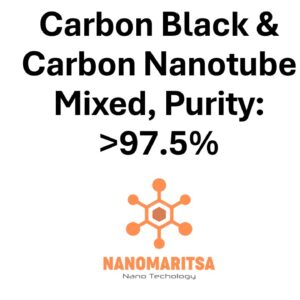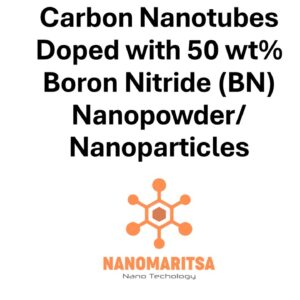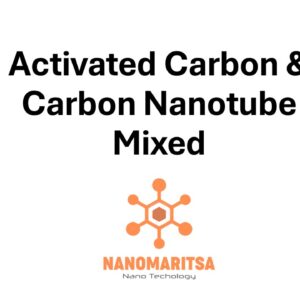Carbon Nanotubes Doped with 50 wt% Iron Oxide (Fe3O4) Nanopowder/Nanoparticles
€608.00
CompareCarbon Nanotubes Doped with 50 wt% Iron Oxide (Fe3O4) Nanopowder/Nanoparticles
Carbon Nanotubes Doped with 50 wt% Iron Oxide refers to a composite material in which carbon nanotubes (CNTs) are chemically modified or treated to incorporate iron oxide particles, with iron oxide making up 50% by weight (wt%) of the composite.
Properties and Benefits of CNTs Doped with 50 wt% Iron Oxide:
- Magnetic Properties:
- Iron oxide itself is magnetic, so doping CNTs with iron oxide can impart magnetic properties to the composite. This can be useful for applications like magnetic storage, sensors, and separation processes.
- Catalytic Activity:
- Iron oxide is often used as a catalyst in various chemical reactions, particularly in oxidation reactions. Doping CNTs with iron oxide could enhance the catalytic activity of the composite, making it suitable for use in catalytic processes, such as in fuel cells or environmental cleanup applications (e.g., water treatment, air purification).
- Improved Electrical Conductivity:
- While CNTs are already highly conductive, the introduction of iron oxide could slightly alter the electrical properties of the composite. The interaction between CNTs and iron oxide could provide unique characteristics that are useful in sensors, energy storage devices (like supercapacitors), or electromagnetic applications.
- Enhanced Mechanical Strength:
- The presence of iron oxide may also improve the composite’s mechanical properties, such as increasing its rigidity or providing resistance to wear and corrosion, especially in specific environments (e.g., high-temperature or chemically aggressive conditions).
- Increased Thermal Conductivity:
- CNTs are known for their excellent thermal conductivity, and the addition of iron oxide might enhance this property in certain conditions, useful for applications in heat management systems.
- Applications:
- Energy Storage and Conversion: The combination of CNTs and iron oxide could improve the performance of devices like batteries, supercapacitors, and fuel cells by enhancing conductivity, catalysis, and energy efficiency.
- Magnetic Materials: The magnetic properties of iron oxide could make this composite useful in data storage devices, magnetic separation processes, or as a magnetic component in sensors.
- Environmental Remediation: The high surface area and catalytic properties of the composite could make it effective for applications such as water treatment (e.g., removing heavy metals, pollutants) or air purification.
- Sensors and Actuators: The unique combination of magnetic, electrical, and mechanical properties makes this material useful for sensors that detect changes in magnetic fields or environmental conditions.
Summary:
Carbon nanotubes doped with 50 wt% iron oxide form a composite that blends the outstanding mechanical, electrical, and thermal properties of CNTs with the magnetic and catalytic properties of iron oxide. This combination opens up new possibilities in a range of applications, including energy storage, magnetic materials, catalysis, and environmental remediation.
Technical Properties:
| 50 wt% Fe3O4 Nanopowder/Nanoparticles | |
| Purity | 99.9% |
| Average Particle Size (nm) | 30 |
| Specific Surface Area (m2/g) | 45.0 |
| Color | brown |
| Shape | near spherical |
| Carbon Nanotubes (Multi Walled Carbon Nanotubes) | |
| Purity | > 97 wt% |
| Color | black |
| Average Outside Diameter (nm) | > 50 |
| Average Inside Diameter (nm) | 5 |
| Length (µm) | 15-25 |
| Tap Density (g/cm3) | 0.15 |
| True Density (g/cm3) | ~2.4 |
| Specific Surface Area (m2/g) | > 65 |
| Ash | < 1.5 wt% |
| Electrical Conductivity (S/cm) | > 98 |
Carbon Nanotubes doped with metal oxide nanopowders show effective improvements in electrical and mechanical properties. Such improvements
include; hardness, tensile strength, specific strenght, and elastic modulus. These improvements result in wide usage of these materials for different
applications. Some of these applications include; 1-drug delivery, 2-biosensors, 3-CNT composites, 4-catalysis, 5-nanoprobes, 6-hydrogen storage,
7-lithium batteries, 8-gas-discharge tubes, 9-flat panel displays, 10-supercapacitors, 11-transistors, 12-solar cells, 13-photoluminescence, 14-templates
| Measurement (gr) | 25 grams, 100 grams |
|---|






